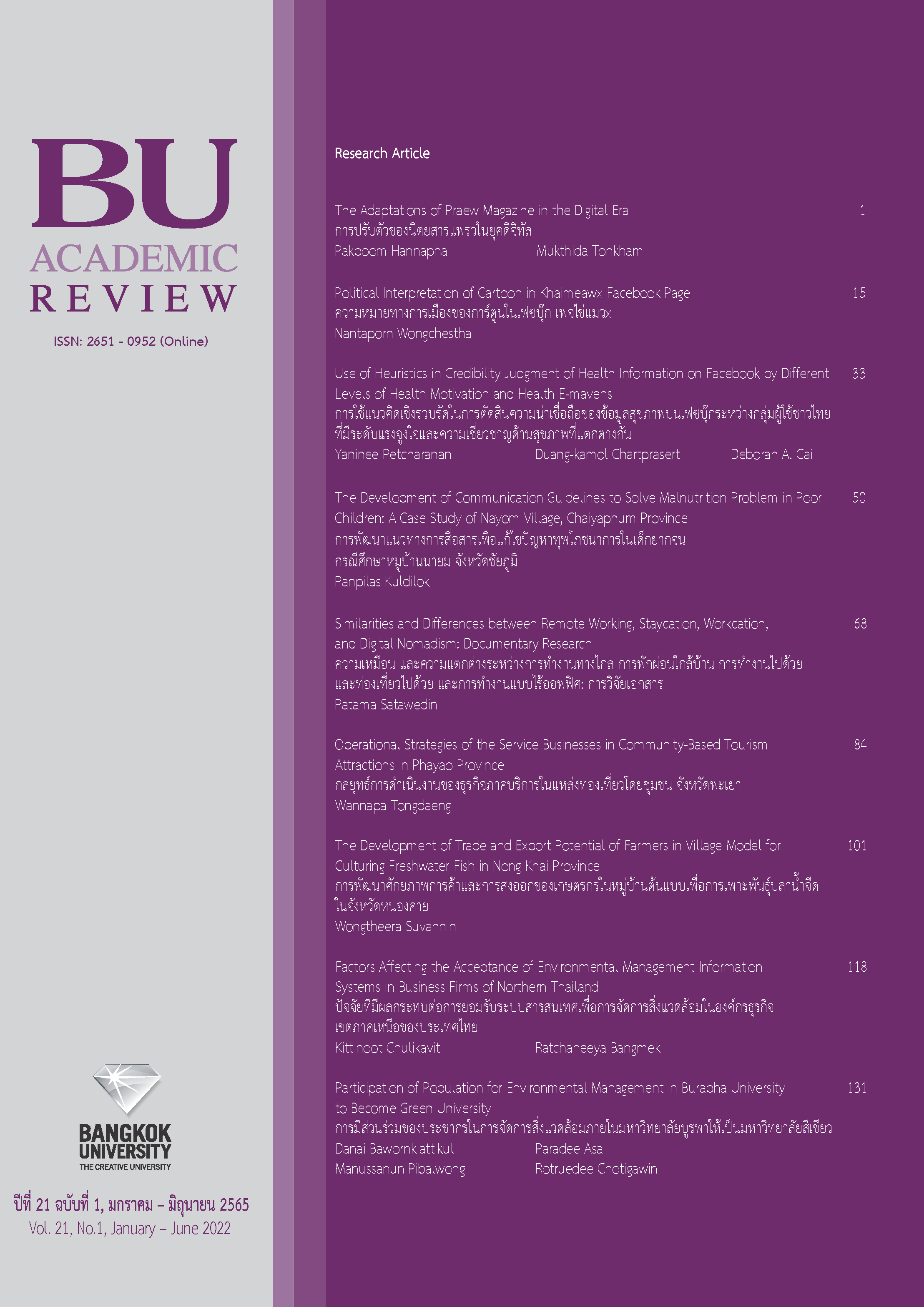ปัจจัยที่มีผลกระทบต่อการยอมรับระบบสารสนเทศเพื่อการจัดการ สิ่งแวดล้อมในองค์กรธุรกิจ เขตภาคเหนือของประเทศไทย
Main Article Content
บทคัดย่อ
งานวิจัยนี้มีวัตถุประสงค์หลักเพื่อศึกษาปัจจัยที่มีผลกระทบต่อการยอมรับและนำระบบสารสนเทศเพื่อการจัดการสิ่งแวดล้อมไปใช้ในองค์กรธุรกิจ แนวทฤษฎีการยอมรับและใช้เทคโนโลยี ได้ถูกนำมาใช้กับงานวิจัยเบื้องต้นเชิงสำรวจนี้ ซึ่งเก็บรวบรวมข้อมูลด้วยแบบสอบถามในระดับองค์กรจากกิจการอุตสาหกรรม (ประเภทบริษัทจำกัด) ใน 6 จังหวัดของภาคเหนือของประเทศไทย ข้อมูลจากแบบสอบถามที่สมบูรณ์จำนวน 175 แบบสอบถาม ได้ถูกนำมาตรวจสอบความเที่ยงตรงเชิงเหมือนและความเป็นมิติเดียว ด้วยการวิเคราะห์องค์ประกอบและยืนยันความสอดคล้องภายในของข้อคำถามด้วยค่าสัมประสิทธิ์แอลฟาของครอนบาค ภายหลังจากการวิเคราะห์ความสัมพันธ์ของตัวแปรด้วยการถดถอยโลจิสติคทวิ พบว่าปัจจัยด้านอิทธิพลทางสังคมเป็นปัจจัยเดียวที่มีอิทธิพลต่อการนำระบบสารสนเทศดังกล่าวไปใช้ในองค์กรอย่างมีนัยสำคัญทางสถิติที่ระดับ 0.05
Article Details

อนุญาตภายใต้เงื่อนไข Creative Commons Attribution-NonCommercial-NoDerivatives 4.0 International License.
บทความที่นำมาสมัครลงตีพิมพ์ในวารสารต้องไม่เคยได้รับการตีพิมพ์เผยแพร่มาก่อน และไม่ส่งต้นฉบับบทความซ้ำซ้อนกับวารสารอื่น รวมทั้งผู้เขียนบทความต้องไม่ละเมิดหรือคัดลอกผลงานของผู้อื่น
เอกสารอ้างอิง
Cabrera-Sánchez, J., & Villarejo-Ramos, A. F. (2019). Factors affecting the adoption of big data analytics in companies. Revista de Administração de Empresas, 59(6), 415-429.
Chen, A. J. W., Boudreau, M., & Watson, R. T. (2008). Information systems and ecological sustainability. Journal of Systems and Information Technology, 10(3), 186-201.
El-Gayar, O. F., & Fritz, B. D. (2006). Environmental management information systems (EMIS) for sustainable development: A conceptual overview. Communications of the Association for Information Systems, 17(1), 756-784.
Elkington, J. (1998). Partnerships from cannibals with forks: The triple bottom line of 21st century business. Environmental Quality Management, 8(1), 37-51.
Hsu, C., Tan, K., Zailani, S. H., & Jayaraman, V. (2013). Supply chain drivers that foster the development of green initiatives in an emerging economy. International Journal of Operations & Production Management, 33(6), 656-688.
Johnstone, N., & Labonne, J. (2009). Why do manufacturing facilities introduce environmental management systems? Improving and/or signaling performance. Ecological Economics, 68(3), 719-730.
Junguitu, A. D., & Allur, E. (2019). The adoption of environmental management systems based on ISO 14001, EMAS, and alternative models for SMEs: A qualitative empirical study. Sustainability, 11(24), 1-17.
Marano, V., & Kostova, T. (2016). Unpacking the institutional complexity in adoption of CSR practices in multinational enterprises. Journal of Management Studies, 53(1), 28-54.
Melnyk, S. A., Sroufe, R. P., & Calantone, R. (2003). Assessing the impact of environmental management systems on corporate and environmental performance. Journal of Operations Management, 21(3), 329-351.
Melville, N. P. (2010). Information systems innovation for environmental sustainability. MIS Quarterly, 34(1), 1–21.
Morrow, D., & Rondinelli, D. (2002). Adopting corporate environmental management systems: Motivations and results of ISO 14001 and EMAS certification. European Management Journal, 20(2), 159–171.
Nadel, S., Galliano, D., & Orozco, L. (2016). Adoption of environmental management systems and organizational changes: The case of the French industrial firms. Journal of Innovation Economics & Management, 3, 109-132.
Nunnally, J. C., & Bernstein, I. H. (1994). Psychometric theory (3rd ed.). New York, NY: McGraw-Hill.
Office of Natural Resources and Environmental Policy and Planning (ONEP). (2017). Nayōbāi læ phǣnkān songsœ̄m læ raksā khunnaphāp singwǣtlō̜m hǣng chāt Phō̜.Sō̜. sō̜ngphanhārō̜ihoksip sō̜ngphanhārō̜ipǣtsip [Policy and Plan for Enhancement and Conservation of National Environmental Quality 2017 – 2037]. Bangkok: Office of Natural Resources and Environmental Policy and Planning (ONEP).
Shahrasbi, N., & Rohani, M. (2018). Organizational readiness in the operations management and information systems disciplines: Concept review and a crisp set comparative analysis. Journal of Supply Chain and Operations Management, 16(3), 246-262.
Singleton, R. A., & Straits, B. C. (1999). Approaches to social research. New York, NY: Oxford University Press.
Sombultawee, K. (2020). Antecedents and consequences of e-commerce adoption for SMEs. Kasetsart Journal of Social Sciences, 41, 256–261.
Teuteberg, F., & Gómez, J. M. (2010). Corporate environmental management information systems: Advancements and trends. Hershey, PA: IGI Global.
Teuteberg, F., & Straßenburg, J. (2009). State of the art and future research in environmental management information systems - A systematic literature review. In I. N. Athanasiadis, A. E. Rizzoli, P. A. Mitkas, & J. M. Gómez (Eds.), Information Technologies in Environmental Engineering (pp. 64–77). Berlin: Springer.
United Nations. (2005). General assembly: Resolution adopted by the general assembly on 16 September 2005. Retrieved June 1, 2021, from https://www.un.org/en/development/desa/population/migration/generalassembly/docs/globalcompact/A_RES_60_1.pdf
Venkatesh, V., Morris, M. G., Davis, G. B., & Davis, F. D. (2003). User acceptance of information technology: Toward a unified view. MIS Quarterly, 27(3), 425–478.
Weng, H., Chen, J., & Chen, P. (2015). Effects of green innovation on environmental and corporate performance: A stakeholder perspective. Sustainability, 7(5), 4997-5026. https://doi.org/10.3390/su7054997
Wrisberg, N., Haes, H. A., Triebswetter, U., Eder, P., & Clift, R. (2002). Analytical tools for environmental design and management in a systems perspective. Dordrecht, Netherlands: Kluwer Academic Publishers.
Yong, A. G., & Pearce, S. (2013). A beginner’s guide to factor analysis: Focusing on exploratory factor analysis. Tutorials in Quantitative Methods for Psychology, 9(2), 79-94.


